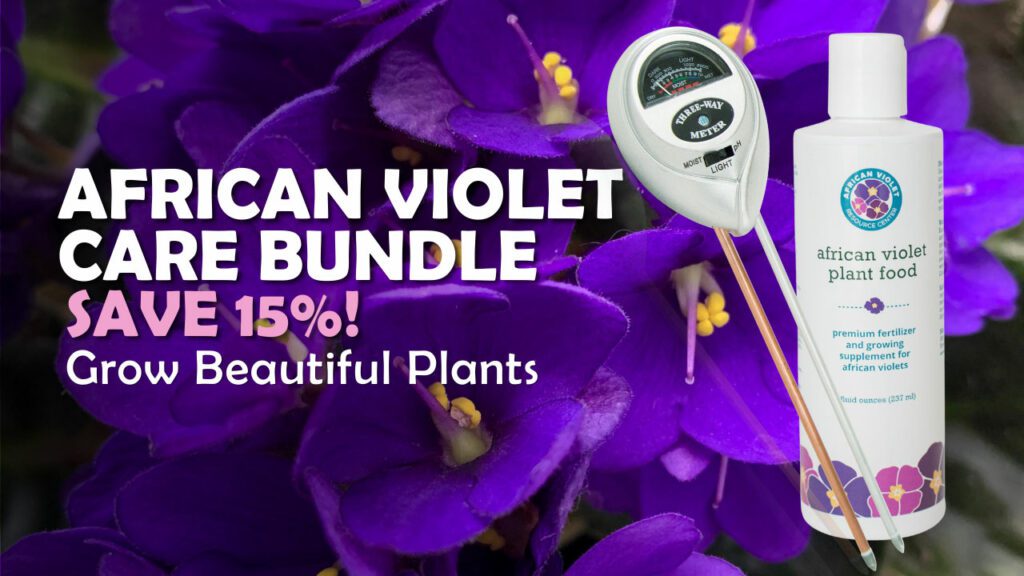Although African violet blooms might seem like the star of the show, African violet leaves have an undeniable appeal. These vibrant, fuzzy leaves are unlike those of any other houseplant, and they seem to call out for attention.
Besides being attractive, African violet leaves can give you clues about your African violet’s health. African violets have a reputation for being a little bit needy, but if you watch for the signs they give, it is not difficult to provide optimal care. You’ll be rewarded with beautiful blooms and eye-catching leaves.
Despite what you might have heard, African violets are not that difficult to care for. With some guidance, you’ll be an African violet pro in no time.
Why Are My African Violet Leaves Curling?
You brought a beautiful African violet home with you, but now you’ve noticed that its leaves seem to be curling. Is this normal or is there something wrong?
Well, it depends. Some African violets have leaves that curl naturally. These leaves are known as “bustled.” Since African violets with this type of leaf are uncommon and not easy to obtain, you will probably know if you have one.
African violets can have leaves that naturally curl, but it is more likely that curling leaves are a sign that something is wrong with your African violet. Keep reading to find out the potential causes of leaf curl and how to fix the problem.

Common Reasons African Violet Leaves Curl
There are several reasons why African violet leaves curl. Even though this is usually an indication that something is wrong, most of the problems are fairly easy to fix. Chances are that your African violet will be back to normal in no time.
Problem #1: The temperature is too cold.
Cold weather is one of the most common reasons why African violet leaves begin to curl. African violets need a temperature of around 70 degrees Fahrenheit.
This is not normally a problem indoors because most homes usually don’t drop too much below this temperature. If your African violets are too close to the window during the winter, you may need to move them farther away.
Curling leaves due to cold temperatures occur more often when African violets are kept outside. You might be able to keep African violets outside during the summer depending on your climate, but, in the U.S. at least, most African violets cannot survive outside year-round. If the temperature drops below 50 degrees Fahrenheit at night, then you’ll soon begin to notice signs of leaf curl and other problems with your outdoor African violet.
How can you tell that leaf curl is due to cold temperature? In addition to the leaves curling under, your African violet will become brittle. The leaves may start to grow closer together and have more fuzz than usual to attempt to combat the cold.
The solution to this problem is simple: move your African violet to a warmer location.
Problem #2: Spider mites are infesting your plant.
Leaf curl can be a sign of a spider mite infestation. Spider mites are tiny and difficult to see. Check the center of the plant for signs of damage because this is where spider mites tend to attack.
Spider mites are one of the least common reasons for leaf curling, but they can be one of the most difficult problems to solve. You do not want spider mites moving onto other nearby plants. Be sure to isolate affected African violets while treating them for mites. Insecticides can sometimes get rid of an infestation.
That being said, to protect other household plants, the best solution might be to get rid of the affected African violet. Disposing of a plant can be disappointing, but it might be necessary.
Problem #3: The plants are receiving too much sunlight or not enough sunlight.
Both too little light and too much light can cause African violet leaves to begin curling. Sounds confusing, right? How are you supposed to know which one is the problem? Thankfully, the two issues result in different types of curling.
African violet leaves that curl upward generally indicate a lack of sunlight. The leaves grow upward in an attempt to get more sunlight. African violets are fairly hardy, so the lack of light won’t immediately damage them. However, they will grow top-heavy over time, which can cause issues.
The solution to not enough sunlight is to move your African violet to a location with more sun. If that is not an option, periodically rotating the plant so that each side gets some time in the brightest patch of light can help a little bit.
Unlike too little light, too much light causes African violet leaves to curl downward or droop instead. Too much light can burn the leaves, causing them to turn yellow or brown.
The solution to this problem is to move your African violet out of intense sunlight. Some people suggest that African violets should never be placed in direct sunlight, but I have had good results with them when placed in a location with direct morning sun. This seems to give them enough sunlight to flower, and I have never had any problems with the leaves burning.
Problem #4: You are not watering your plants enough.
If you’ve ever accidentally killed a plant before, it was most likely either from lack of water or too much water. Leaf curling can sometimes be a warning sign that you are not providing enough water for your African violet.
When an African violet’s leaves start to look droopy and lifeless, then you might be underwatering it. The soil should be allowed to dry out between waterings, but it should not be allowed to get bone-dry.
Place your African violet in a container of water that comes up an inch or two on the African violet’s pot, and allow it to soak for 20 minutes. Regularly watering your plant should solve the problem if the leaf curling is due to a lack of water.
African violets have a reputation for being finicky, but that has more to do with their flowering habits than their ability to survive in slightly hostile conditions. I’m not going to admit exactly how long I have forgotten to water my African violets before, but I can tell you that they can survive for a surprisingly long time without being watered.
Just don’t neglect them too often, and they’ll bounce back quickly when you accidentally do.
Problem #5: Too much watering has caused root rot.
For most houseplant lovers, overwatering is more of a problem than underwatering. Overwatering can lead to root rot and prevent the roots from being able to access enough oxygen. When this happens, the leaves will begin to droop over and the stems will begin turning mushy and brown.
To prevent root rot from happening in the first place, make sure to use a soil mix made for African violets. Regular indoor potting soil mix holds on to too much water. Don’t water your African violets if the soil is still moist from the previous watering.
If you notice that your African violet has droopy leaves that are beginning to curl under and the stems are turning brown, it’s time to inspect the roots. Carefully remove the plant from its pot. Cut off any roots that are dark and mushy. As long as some light, firm roots remain, the plant is likely to recover.
Refresh the soil in the container and repot your African violet. Use a Root Supplement to help treat and prevent any further root system infections. Water less frequently than before and be sure that water has a way to drain properly.
How Often Should African Violets Be Watered?
Too much water is the main reason for root rot, which in turn leads to curling leaves. How do you know if you are watering your African violets just the right amount?
There is no one correct answer to how often you need to water your African violets. Many different factors, including the location, the temperature, the size of the plant, and even the type of container, can affect how often you need to water an individual African violet.
The best way to tell if your African violet needs to be watered is to check the soil. If the soil is still moist when you stick your finger into the top of it, don’t water quite yet. If the soil is dry, then it’s time to water.
Err on the side of allowing the soil to dry out a bit rather than watering too soon. A good African violet potting soil will hold on to moisture for a while. My African violets planted in tiny plastic pots still have moisture in the soil a full week after I last watered them. Even though I like to water all of my plants at the same time each week, I’ll let these dry out for another few days before watering (Or maybe I’ll forget and not water them until my watering day next week. They’ll be fine if this happens every once in a while.)
How Do You Revive a Wilted African Violet?
There’s nothing worse than noticing that your once-thriving African violet has begun to wilt. Don’t panic yet, though. As long as you act early enough, you can usually revive a wilted African violet.
African violets tend to wilt for one of four reasons: either they are too cold, they need more water, they have been overwatered, or you have just repotted the African violet.
If your African violet is in a location that is too cold, move it to a warmer area. African violets prefer to stay at a temperature of around 70 degrees Fahrenheit. As long as you move the African violet before too much damage has been done, it will start to look better in a few days.
What if you are sure that the temperature has been warm enough, but your African violet is still wilted? Then water is probably the issue.
If you have not watered your African violet enough, the leaves will begin to droop down and look lifeless. Soaking the plant in a container of water for about 20 minutes will help revive the plant. Sometimes African violets perk up within 24 hours after soaking. Other times it takes a bit longer. Just make sure to continue to water the African violet regularly in the future.
On the other hand, overwatering could be the culprit behind the wilting. Roots that sit in water for too long are unable to access oxygen. As the roots turn soft and die, the plant suffers as well. To solve this problem, remove any roots that are soft and brown. Change out the soil, making sure to use African violet potting mix rather than a general potting mix. Water regularly, but make sure that the soil dries out between waterings.
The final reason that African violets wilt is because they have just been repotted. This wilting is normal and temporary. As long as you are properly caring for the plant, it should look better without any extra fuss in a few days.
See also: 6 Signs Your African Violet Is Dying and How to Revive It
Join the African Violet Club!
Whether you’re just starting out or are a seasoned grower, African Violet Resource Center has everything you need to help your plant grow vibrant and strong. Explore our other articles, visit our online shop, and connect with other houseplant lovers in our Facebook group to learn everything you need to know about this rewarding hobby!
More Great African Violet Resources
8 Tricks to Get Your African Violets to Bloom Again
The Perfect African Violet Soil Potting Mix







